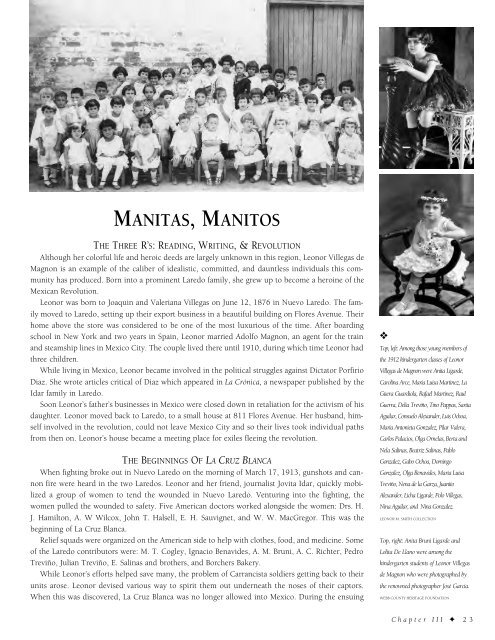Historic Laredo
An illustrated history of the city of Laredo and the Webb County area, paired with the histories of companies, families and organizations that make the region great.
An illustrated history of the city of Laredo and the Webb County area, paired with the histories of companies, families and organizations that make the region great.
You also want an ePaper? Increase the reach of your titles
YUMPU automatically turns print PDFs into web optimized ePapers that Google loves.
MANITAS, MANITOS<br />
THE THREE R’S: READING, WRITING, & REVOLUTION<br />
Although her colorful life and heroic deeds are largely unknown in this region, Leonor Villegas de<br />
Magnon is an example of the caliber of idealistic, committed, and dauntless individuals this community<br />
has produced. Born into a prominent <strong>Laredo</strong> family, she grew up to become a heroine of the<br />
Mexican Revolution.<br />
Leonor was born to Joaquin and Valeriana Villegas on June 12, 1876 in Nuevo <strong>Laredo</strong>. The family<br />
moved to <strong>Laredo</strong>, setting up their export business in a beautiful building on Flores Avenue. Their<br />
home above the store was considered to be one of the most luxurious of the time. After boarding<br />
school in New York and two years in Spain, Leonor married Adolfo Magnon, an agent for the train<br />
and steamship lines in Mexico City. The couple lived there until 1910, during which time Leonor had<br />
three children.<br />
While living in Mexico, Leonor became involved in the political struggles against Dictator Porfirio<br />
Diaz. She wrote articles critical of Diaz which appeared in La Crónica, a newspaper published by the<br />
Idar family in <strong>Laredo</strong>.<br />
Soon Leonor’s father’s businesses in Mexico were closed down in retaliation for the activism of his<br />
daughter. Leonor moved back to <strong>Laredo</strong>, to a small house at 811 Flores Avenue. Her husband, himself<br />
involved in the revolution, could not leave Mexico City and so their lives took individual paths<br />
from then on. Leonor’s house became a meeting place for exiles fleeing the revolution.<br />
THE BEGINNINGS OF LA CRUZ BLANCA<br />
When fighting broke out in Nuevo <strong>Laredo</strong> on the morning of March 17, 1913, gunshots and cannon<br />
fire were heard in the two <strong>Laredo</strong>s. Leonor and her friend, journalist Jovita Idar, quickly mobilized<br />
a group of women to tend the wounded in Nuevo <strong>Laredo</strong>. Venturing into the fighting, the<br />
women pulled the wounded to safety. Five American doctors worked alongside the women: Drs. H.<br />
J. Hamilton, A. W Wilcox, John T. Halsell, E. H. Sauvignet, and W. W. MacGregor. This was the<br />
beginning of La Cruz Blanca.<br />
Relief squads were organized on the American side to help with clothes, food, and medicine. Some<br />
of the <strong>Laredo</strong> contributors were: M. T. Cogley, Ignacio Benavides, A. M. Bruni, A. C. Richter, Pedro<br />
Treviño, Julian Treviño, E. Salinas and brothers, and Borchers Bakery.<br />
While Leonor’s efforts helped save many, the problem of Carrancista soldiers getting back to their<br />
units arose. Leonor devised various way to spirit them out underneath the noses of their captors.<br />
When this was discovered, La Cruz Blanca was no longer allowed into Mexico. During the ensuing<br />
❖<br />
Top, left: Among those young members of<br />
the 1912 kindergarten classes of Leonor<br />
Villegas de Magnon were Anita Ligarde,<br />
Carolina Arce, María Luisa Martinez, La<br />
Güera Guardiola, Rafael Martinez, Raul<br />
Guerra, Delia Treviño, Tino Pappas, Sarita<br />
Aguilar, Consuelo Alexander, Luis Ochoa,<br />
María Antonieta Gonzalez, Pilar Valera,<br />
Carlos Palacios, Olga Ornelas, Berta and<br />
Nela Salinas, Beatriz Salinas, Pablo<br />
Gonzalez, Gabo Ochoa, Domingo<br />
Gonzalez, Olga Benavides, María Luisa<br />
Treviño, Nena de la Garza, Juanito<br />
Alexander, Licha Ligarde, Polo Villegas,<br />
Nina Aguilar, and Nina Gonzalez.<br />
LEONOR M. SMITH COLLECTION<br />
Top, right: Anita Bruni Ligarde and<br />
Lolita De Llano were among the<br />
kindergarten students of Leonor Villegas<br />
de Magnon who were photographed by<br />
the renowned photographer José García.<br />
WEBB COUNTY HERITAGE FOUNDATION<br />
Chapter III ✦ 23
















